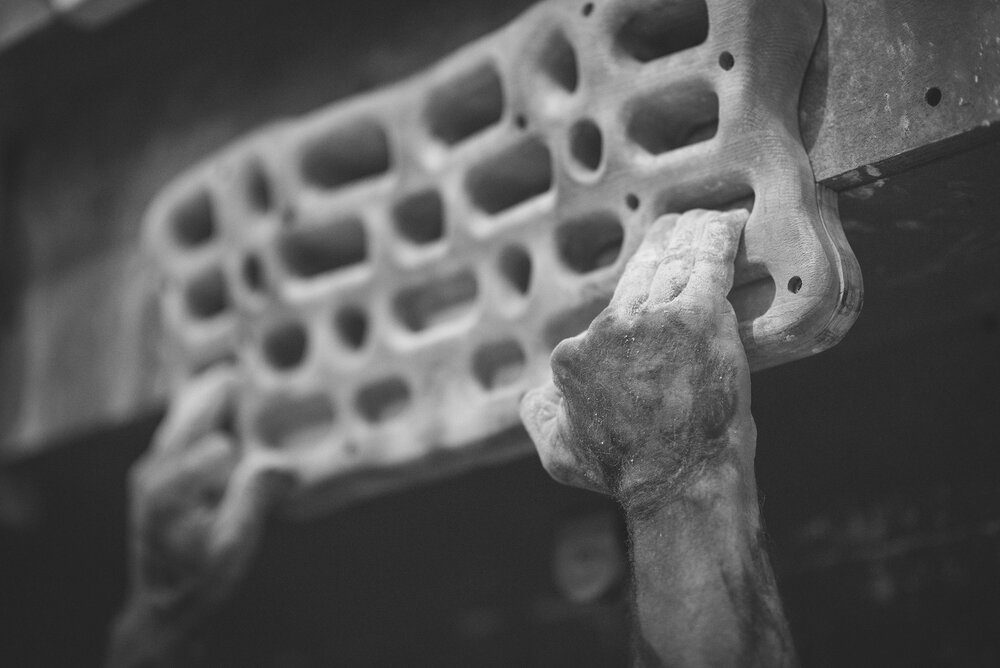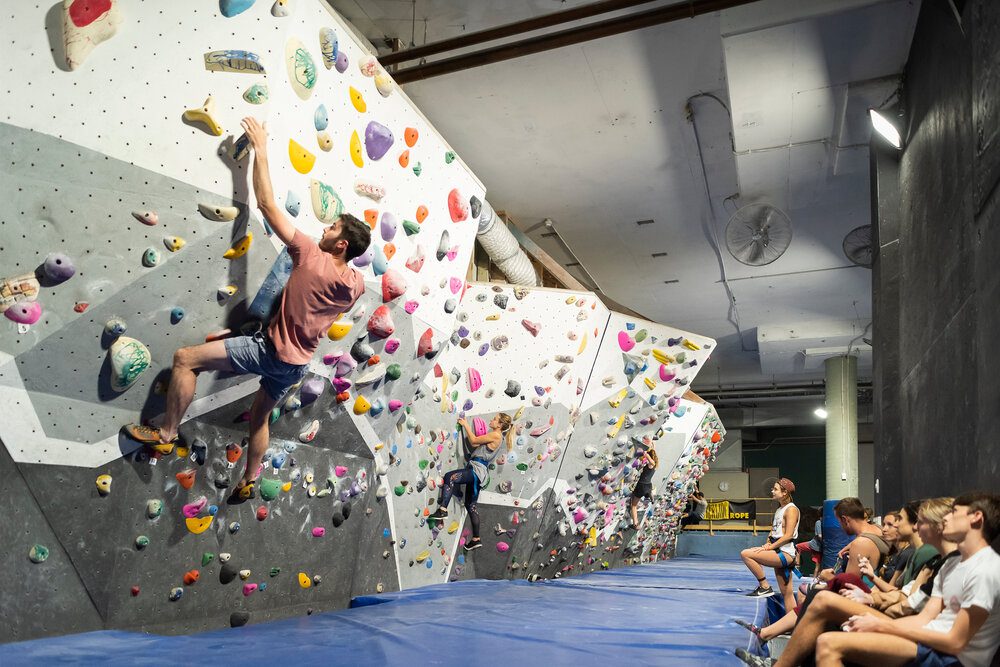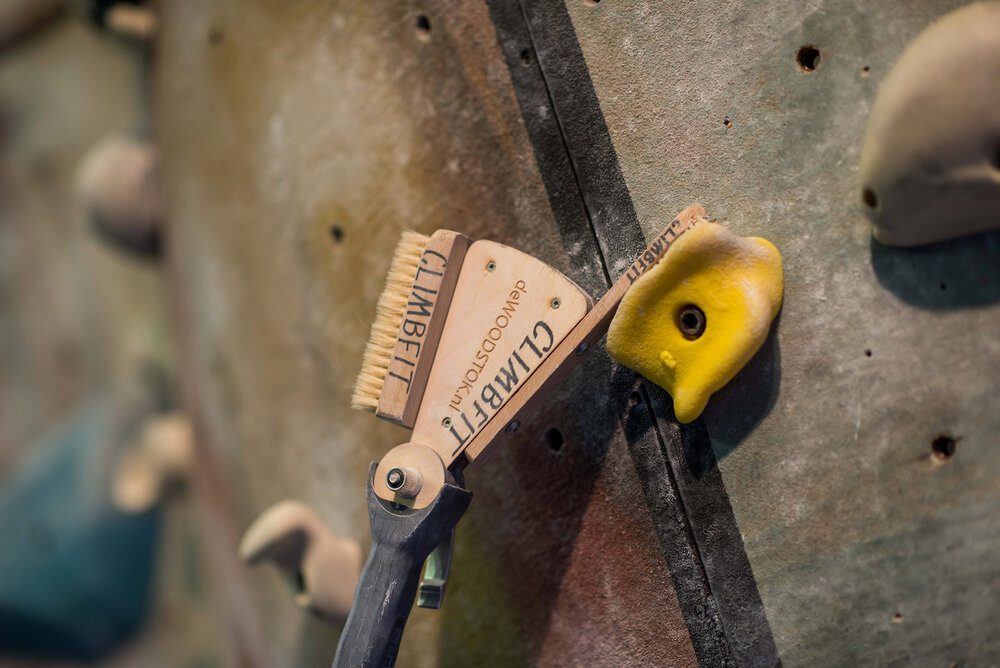Bouldering is a brilliant sport that can provide a full-body workout in one activity! In this month's article, we cover essential tips for beginner bouldering and strength training with Sarah Josephsen.
Pull-ups are great, but training with unequal weight distribution is better! Unlike a pull-up, you never climb with a 50/50 weight distribution between your arms. When climbing, one arm is always pulling more weight than the other.
Bouldering is more focused on strength and power compared to sport climbing. Therefore, the ability to hold and move a lot of weight with one arm becomes essential.
Start doing typewriter pull-ups. Building your one-arm strength will help you to glide through difficult crux moves like gastons, cross-throughs and big burly throws. These are called "typewriters" because that's precisely what you look like when performing these pull-ups!
Typewriter pull-ups are a great exercise that utilises a wide grip, pulling your chest to the bar, and then shift your weight from one arm to the other, extending the opposite arm out.
Here is a link to a small video that demonstrates the typewriter pull-up courtesy of @lind.slaaay
Beginners to bouldering often find the overhang climbs a challenge. The upper body has to work harder to hang onto the wall when your feet are no longer underneath to support it. It's crucial to keep your feet on the wall when you climb, to reduce the weight that your upper body has to hold. If the feet slip off the wall, the climber usually falls or becomes exhausted, trying to get them back on the wall.
Having a strong core can help you keep your feet on the wall and make it easier to get your feet back on the holds if they slip off. However, being able to do 100 sit-ups is not very useful for bouldering. You need strength in your hip flexors, quadriceps and all abdominal muscles to climb the hard boulder routes. You need to be able to hang and extend your leg up to high, often very small footholds. You need to be able to hang and crunch your body into a ball to get your toe onto a hold near your hand!
Sprinters Step,
Hanging toe touches and the
Hanging L sit.
We also have a great video below that covers core training for climbers in detail below. Sit back, relax and let your eyes do the work!
Finger strength is a common limitation for boulderers. Finger strength and forearm endurance become increasingly crucial as you go up bouldering grades. Making use of drop-sets and pyramid sets on the hang boards are a great way to increase finger strength and forearm endurance for bouldering.
Unsure about how to start? Check out our QUICK START GUIDE TO HANGBOARDING Article

Mobility is easy to train and makes a big difference in climbing performance. Static stretching the muscles around the shoulder for over 15s is a simple way to increase flexibility. However, strength through the entire range of motion is also essential for both performance and injury prevention.
Training through a full range of motion and including both pulling and pushing exercises in your training is a great way to build a resilient upper body and protect against injury. Push-ups, shoulder press and cable rows are examples of activities that can increase strength through different planes/range of motion/movements.
Preparing your muscles is a crucial element of bouldering. You can begin by foam rolling any major muscle group which will help you wake them up. This loosens up tight muscles, so they work how you need them to. You will also increase your range of motion.
This will ensure you can fully extend and make more complicated movements. You will be able to reach greater heights during your workout and get the results you want. Tight Lats are pretty typical for climbers, so we suggest trying the roller on those first.
Place your foam roller on the ground. Next, lie on your side on top of the roller. Position the roller under your armpit at right angles to your body. Be gentle - you may not be able to put all your body weight on it at first. Gently roll from your armpit down your lats and back up again. Put a timer on for 45seconds and then swap sides.

Ideally, you should have someone spotting when you are bouldering. If you are new to the sport, it is easier when you have someone help you learn the routes and, it's also fun to attack the routes with a buddy.
You can challenge and encourage each other while you learn, and you can track each other's progress over time. If you are looking for a partner to climb with and cant round up a friend, Climb fit runs Friday night social climbs that are a great way to meet new bouldering buddies and make new friends.
check out this article for more 👉 TEACH YOUR FRIENDS HOW TO CLIMB
Side pulls and underlings are an essential part of bouldering. There are always holds that you can not grip vertically. Being ill-prepared for this makes an injury more likely. Even if you are a beginner
As the name suggests, sidepulls have an opening on the side. Underclings have the opening at the bottom. This is different from a typical climb with a vertical hold. Sidepulls require you to wrap your fingers on the side. Your hips need to lean in the opposite direction.
Undercling holds differ as you pull from underneath. You will need to bring your feet high and push up. Keep your hips close to the wall, bring your feet high and push up. Your hips must stay close to the real rock wall.
As a beginner, you don't have the same training base as the instructors. Your body needs time to adjust to the new climbing life. If you climb too often, all your prep isn't going to matter. Your warm-up could be spectacular, and it won't matter. Your technique could be flawless, and it won't matter.
Like all sport's If you climb too often, eventually, you run the risk of injury. The easiest way to prevent injury is via conditioning and strength training.
Consistent Strength training not only builds muscle, but the repetition of fundamental techniques will also help you progress your bouldering skills, allowing you to climb faster with less fatigue over time.

You would not complete a bench press at a weight beyond your limit. Weight machines have different levels and so do bouldering courses. It's essential to know about bouldering grades. That way you won't be punching above your weight. Grades are like ski hills they have number and number-letter combinations that vary depending on your country. This helps to show the difficulty of a bouldering problem clearly.
Once you hone your skills, the grades won't be as significant. You can rely on your judgement or your level of strength.
If you want to read more about learning to read indoor climbing routes, check out our article here
Would you get on a bike without knowing basics? No. In that case, you shouldn't with bouldering either. If you are a rock climber, some of the skills will be the same. But, the big difference is that there is no rope in bouldering which can make the sport a little more challenging.
Climb fit runs Beginner and Intermediate bouldering classes coached by our expert staff. If you'd like to learn more about our upcoming courses and dates, check out what's on here.